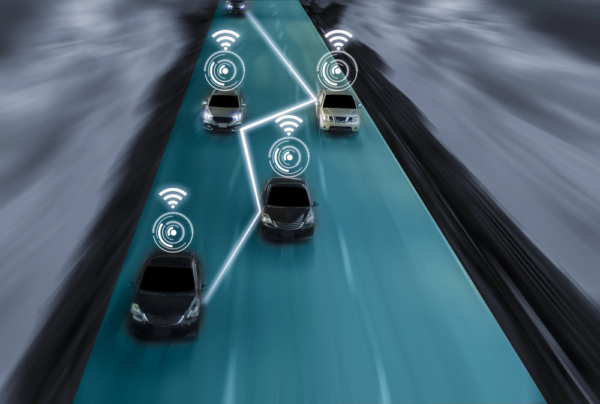
The automotive industry is changing before our very eyes with the proliferation of connected vehicles. Equipped with advanced sensors, internet connectivity, and sophisticated software, these cutting-edge vehicles are transforming how we drive by offering features like real-time navigation, over-the-air updates, and all kinds of autonomous and connected capabilities. Yet the same connectivity that empowers these vehicles also exposes them to cybersecurity threats. That’s why cybersecurity for connected vehicles has become a top priority for automakers and tech providers alike. Let’s talk through how cybersecurity in automotive is being developed to meet these threats.
Cybersecurity for Connected Vehicles in Automotive Design and Manufacturing
Connected vehicles rely on a complex ecosystem of technologies that include vehicle-to-vehicle (V2V) communication, cloud integration, and infotainment systems. Each of these connection points is a potential entryway for cybercriminals. Hackers can exploit vulnerabilities to steal sensitive data, manipulate vehicle functions, or even take control remotely. Researchers have already been able to demonstrate how easily attackers could compromise a car’s braking system or disable its steering via unsecured wireless networks. As vehicles become more integrated with the Internet of Things (IoT), the attack surface expands expands making cybersecurity for connected vehicles more critical than ever.
The stakes are high for manufacturers. A single breach could erode consumer trust, trigger costly recalls, and potentially lead to massive regulatory penalties. At SAAB RDS, we partner with manufacturers to help you address these challenges head-on by bringing our digital transformation expertise to your connected vehicle design. The threats are real, but so are the solutions.
More Than a Car: Why Cybersecurity for Connected Vehicles Starts in Automotive Design
Cybersecurity isn’t just about protecting a single vehicle; it’s about securing the entire ecosystem, from supply chains all the way through to the end users (drivers) and even the people around them who could be affected by a problem. Modern manufacturers must be able to anticipate threats like software supply chain attacks, where malicious code is injected during development, or phishing schemes that will target drivers. As the connected vehicle ecosystem expands, so does the arsenal of cybersecurity solutions designed to protect it.
At SAAB RDS, we’re ready to help you with integrating these advanced tools into your manufacturing process so you can deliver vehicles that are as secure as they are innovative. From encryption to intrusion detection, these technologies are critical for thwarting cyber threats.
Encryption Tech: The Backbone of Cybersecurity for Connected Vehicles
A cornerstone of vehicle cybersecurity is encryption. When data gets transmitted between a vehicle’s components, like the electronic control units (ECUs) and external cloud servers, it has to be kept safe in case of interception. Strong encryption protocols scramble this data so it’s unreadable to unauthorized parties. For example, when a connected vehicle receives an over-the-air (OTA) software update, the right encryption can ensure that only legitimate updates from the manufacturer get installed. This keeps hackers from injecting malicious code into an update.
Intrusion Detection and Prevention Systems (IDPS)
These systems monitor a vehicle’s network for suspicious activity. This might be an unusual command sent to the braking system or an unauthorized access request to the infotainment unit. IDPS quickly gathers and analyzes data as it’s happening and can thus flag potential threats. In many cases, it can even block them before they cause any harm.
Imagine a hacker attempting to exploit a flaw in a vehicle’s V2V communication: if IDPS could detect the anomaly and isolate the compromised system, it would protect not only the car but also others on the road.
Secure Software Development
True safety means more than just catching problems once they’ve already arisen. Secure software development is meant to stop a lot of the problems before they can even arise. Secure coding standards and testing can identify and patch any weaknesses before a vehicle hits the market; with this built into the software lifecycle, you can stay ahead of threats like zero-day exploits.
How AI and Machine Learning Can Help
As cyber threats grow more sophisticated, traditional rule-based security measures alone aren’t enough. AI and ML offer dynamic, adaptive solutions that learn from data, anticipate attacks, and respond instantly; and they’re what’s needed in a world of sophisticated cyber threats.
AI-driven cybersecurity systems are especially good at anomaly detection. Connected vehicles generate vast amounts of data on everything from engine diagnostics to driver behavior, and machine learning algorithms can analyze this data to establish a baseline of normal operation. When something deviates from the norm, AI flags it instantly. For instance, if a hacker attempts to spoof a vehicle’s GPS signal, ML will detect this irregularity and alert the system to switch to a backup navigation source.
AI also enhances threat prediction. By studying patterns from past cyberattacks across the industry, ML models can forecast potential vulnerabilities in your vehicle’s software or hardware. This predictive capability allows you to patch weaknesses before they’re exploited. AI also streamlines incident response. Say there is a cyberattack: AI systems can autonomously isolate the affected components by, say, locking down a compromised infotainment system. It can also instantly alert both the driver and the manufacturer. This kind of fast response means damage stays limited and you don’t end up with cascading failures across the vehicle’s network.
Regulatory Compliance and Ecosystem Collaboration
Regulatory bodies worldwide are stepping in to enforce cybersecurity standards, and staying in compliance here isn’t just a legal obligation. It also gives you a competitive advantage: you’re building trust with consumers and proactively preventing the kind of breaches that can end in recalls, fines, and potentially brand-destroying reputational damage. Data privacy is another regulatory focus, especially now that connected vehicles are collecting sensitive information like location history and driver preferences. Regulations such as GDPR in Europe require manufacturers to protect this data from breaches.
There‘s a lot more to it: and we can help. Reach out to SAAB RDS now.
